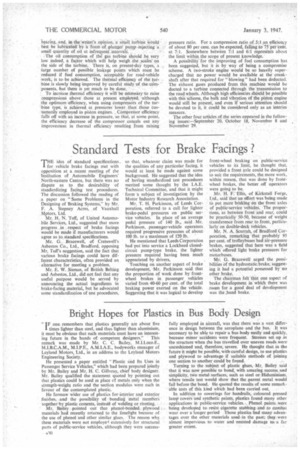Standard Tests for Brake Facings ?
Page 32

If you've noticed an error in this article please click here to report it so we can fix it.
T"idea of standard specificationsfor vehicle brake facings met with opposition at a recent meeting of the Institution of Automobile Engineers' North-eastern Centre, but there was no dispute as to the desirability of standardizing facing lest procedures. The discussion followed the reading of a paper on "Some Problems in the Designing of Braking Systems." by Mr. F. A. Stepney Acres, of Vauxhall Mptors, Ltd.
Mr. H. N. Tuff, of United Automobile Services, Ltd., suggested that more progress in respect of brake facings would be made if manufacturers would agree as to standard specifications.
Mr. G. Bracewell, of Cresswell's Asbestos Co., Ltd., Bradford, opposing Mr. Tuff's suggestion, said the fact that various brake facings could have different characteristics, often provided an alternative for meeting a problem.
Mr. E. W. Sisman, of British Belting and Asbestos, Ltd., did not feel that any useful purpose would be served by announcing the actual ingredients in brake-facing material, but he advocated some standardization of test procedures, so that, whatever claim was made for the qualities of any particular facing, it would at least be made against some background. He suggested that the idea of having standardized test procedures merited some thought by the I.A.E. Technical Committee, and that it might form a subject of investigation by the Motor Industry Research Association. Mr. T. H. Parkinson, of Leeds Corporation, referred to a call for lighter brake-pedal pressures on public service vehicles. In place of an average pedal pressure of 140 lb., said Mr. Parkinson, passenger-vehicle operators required progressive pressures of about 100 lb. to a maximum of 120 lb. • He mentioned that 'Leeds Corporation had put into service a Lockheed closedcircuit pump-type brake, the lighter pressure required having been much appreciated by drivers.
Touching on another aspect of brake development, Mr. Parkinson said that the proportion of work done by frontwheel brakes in passenger vehicles varied from 40-60 per cent. of the total braking power exerted on the vehicle. Suggesting that it was logical to develop front-wheel braking on public-service vehicles• to its limit, he thought that, provided a front axle could be designed to suit the requirements, the more work, within reason, that was done by frontwheel brakes, the better off operators were going to be.
Mr. H. F. Ellis, of Kirkstall Forge, Ltd., said that an effort was being made to put more braking on the front axles of puplic-service vehicles. The proportions, as between front and rear, could be practically 50-50, because of weight transference from rear to front, particularly on double-deck vehicles.
Mr. N. A. Scurrah, of Bradford Corporation, remarking that probably 95 per cent. of trolleybuses had air-pressure brakes, suggested that here was a field which offered light brake pressures for motorbuses.
Mr. G. Bracewell urged the possibilities of the hydrostatic.'brake, suggesting it had a potential possessed by no other brake.
The chairman felt that one aspect of brake development in• which there was rot= for a good deal of development was the ,hand brake.




































































